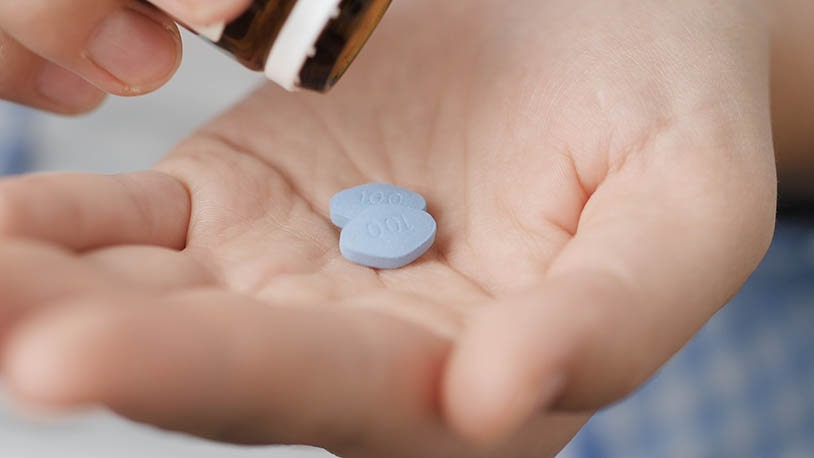
Naltrexone is a prescription-only medication designed to treat narcotic drug addiction and alcohol dependence, hence, improving overall health. The drug works on fighting off cravings and relapsing tendencies, often seen during early phases of opiate withdrawal. Sold under brand names such as Vivitrol and ReVia, it is also used off-label in the treatment of different conditions.
Table Of Contents:
However, many who use it do not understand what this medication actually is and what effect it has on their health. In this article, we will cover the details of this medication along with its various uses, benefits, and potential side effects.
What Is Naltrexone HCl?
The medication is most commonly used to help in the management of addiction. Specifically, addiction to opiates and alcohol. Other Naltrexone uses range from treating pain disorders to helping manage the symptoms of Parkinson’s disease and obesity.
Sold under the brand name Vivitrol, among others, it comes in different formulations. The drug can be delivered by injection, through an implant, or by taking pills. While pills are most often used in low-dose Naltrexone (LDN) therapy, they can be used in the treatment of any condition that benefits from the drug.
Naltrexone Drug Class
Like all medications, Naltrexone HCL belongs to a specific drug class which helps with easier prescription and understanding of the medication, resulting in improved recovery. This drug class is determined by how the medication functions. Vivitrol’s drug class determines a lot about it, from what it can treat to how easy it is to access. Vivitrol interacts with the opioid receptors by occupying them and preventing other substances from interacting with them. This means that the correct drug class for Naltrexone is an opioid antagonist. This is what the medication benefits come from, making Naltrexone for alcohol dependence treatment a great solution.
Is Naltrexone A Controlled Substance?
A controlled substance is anything that is known to be addictive, whether it has demonstrable therapeutic benefits or not. Vivitrol is not a controlled substance because it has never been shown in clinical trials to be addictive. However, this definition of the term is based on how the DEA uses it. The general population may consider it to be a controlled substance because people cannot get the medicine over the counter. The Vivitrol drug requires a prescription, but beyond that is not restricted.
The drug schedule is used to classify controlled substances based on their potential for abuse weighed against their therapeutic benefits. Dependence and Vivitrol addiction are not amongst the Vivitrol side effects. In fact, the drug has very few potentially fatal effects on the health. Because it is not addictive, and therefore not a controlled substance, there is no schedule classification for this drug.
Naltrexone Brand Name
Naltrexone is the generic name for Naltrexone Hydrochloride. The most well-known brand name is Vivitrol. However, other brand names include Revia and Depade. There are also numerous generic drug options available. The only Vivitrol provider is Alkermes. Barr laboratories make Revia medication, while Mallinckrodt Pharmaceuticals makes Depade. Apotex, Aidarex, Pd Rx Pharmaceuticals, and AvKare are just a few of the manufacturers making generic versions of the drug.
Because Vivitrol comes in a variety of formulations, not all manufacturers will offer all methods of ingestion. Depending on the method, the half-life of the medication may change. Opting for a different manufacturer may also alter the Vivitrol dosages available. Users should speak with their doctor before switching versions of the medication to ensure proper health.
Naltrexone Dosage Forms And Strength
The medicine is available in two different doses for two different methods of drug delivery. Tablets, taken orally, are available as 50mg pills, under different brand names, for example, one of which is ReVia. It is also available as an intramuscular injection under the brand name Vivitrol. The appropriate dosage will be prescribed by the primary care physician, depending on the specificities of each case. The main aim of the medication is to improve the recovery period and the appropriate dosage for this purpose will be prescribed by the primary doctor.
Choosing the correct Vivitrol dose is crucial for successful alcohol and opioid withdrawal management. The dosages differ depending on what the medication is intended to treat. It is, therefore, important to learn how Vivitrol dosing is determined and in what forms it is available in addition to discussing the treatment plan with a medical professional. Even though Naltrexone abuse is rare, changing or missing doses is not recommended with this specific medication.
What is Low Dose Naltrexone?
Low Dose Naltrexone is, as the name describes, the medication in low enough doses that it has no narcotic effect. LDN is a tenth of the normal dose of the drug, and it is used for its anti-inflammatory and analgesic properties. It binds to the endorphin receptors, blocking them for upwards of four hours, and results in an increase of the natural endorphins.

It is this effect that helps manage pain in patients. As it provides pain relief, there is a likelihood of Naltrexone abuse, however, the risk is minimal.
Is There A Risk Of Naltrexone Addiction?
Given that it is prescribed to people battling addictions, the abuse potential of Naltrexone addiction is considered to be nonexistent. This is mostly because the medication does not produce any euphoric effects to drive addiction and cannot be altered or taken in a way that could potentially cause those effects.
The drug belongs to the medication class called opioid antagonists. This means that it prevents opioid receptors from functioning properly. If users take Vivitrol, they will not experience euphoria, feelings of well-being, pain relief, and other aspects of taking opioid medication or drinking alcohol. As there is no euphoria or any other positive feeling attached to taking the drug, the rate of Naltrexone abuse and potential Naltrexone addiction are extremely low, basically non-existent.
Vivitrol negates, or at the very least reduces, the sensations caused by drugs and alcohol, users can feel tempted to take more in hopes of still achieving euphoria. However, while Vivitrol blocks the sensations of euphoric feelings, it does not limit in any way the other effects substances can have on the body. These effects include impaired respiratory function, reduced motor skills, and confusion. This is why, despite the low risk of Naltrexone addiction, the drug is a tightly regulated substance as users can easily overdose and experience significant injury, coma, or even death. On the other hand, that does not mean that people will not try to abuse it or misuse it by taking it with other substances. In case of abuse, it is critical to find addiction treatment as soon as possible.
Naltrexone Withdrawal And Stopping
This medication is one that is not thought to develop any form of physical dependence. As such, there is no such thing as withdrawal issues with this medication. Weaning off of the drug is recommended, but as it produces no physical dependence and has zero potential for addiction, withdrawal and detoxification concepts do not apply to this medication.
However, just because there is no such thing as withdrawal of this drug does not mean users should feel free to stop using it on their own. Depending on the condition, it is being used to treat, stopping the drug without the right help can be dangerous.
Additionally, how the medication should be stopped depends on the motivation for doing so. If the user is trying to decide between Naloxone vs Naltrexone, they need to speak with an addiction specialist. If their concern is this medicine and weight loss interconnected, help from a dietician might make the medication work. Ultimately, help is needed.

Getting Help With Addiction
Naltrexone is an opioid-opposing medication that can help people fight addiction, which is a disorder with possible genetic components. Due to the reduced possibility of addiction, dependence, and withdrawal, this drug is used commonly to treat addiction. Whether someone is looking to get started with Vivitrol treatment or wants to stop it, medical supervision is required. Addiction rehab centers are often the best place to get help. There, they can determine the best course of action in an environment that is safe and supportive. Moreover, round-the-clock medical care can be provided in the rehab centers, reducing the possibility of an adverse reaction with this medicine and preventing relapse.
Hope Without Commitment
Find the best treatment options. Call our free and confidential helpline
Most private insurances accepted
Find Drug Rehabilitation Centers Near You Anywhere In the US
Addiction Resource team has compiled an extensive list of the top drug rehabilitation facilities around the country. Use our locator tool to find the best centers near you.
Page Sources
- Aboujaoude, E., & Salame, W. O. (2016). Naltrexone: A Pan-Addiction Treatment?. CNS drugs, 30(8), 719–733. https://doi.org/10.1007/s40263-016-0373-0
- Younger, J., Parkitny, L., & McLain, D. (2014). The use of low-dose naltrexone (LDN) as a novel anti-inflammatory treatment for chronic pain. Clinical rheumatology, 33(4), 451–459. https://doi.org/10.1007/s10067-014-2517-2
- Li, Z., You, Y., Griffin, N., Feng, J., & Shan, F. (2018). Low-dose naltrexone (LDN): A promising treatment in immune-related diseases and cancer therapy. International immunopharmacology, 61, 178–184. https://doi.org/10.1016/j.intimp.2018.05.020
- Hulse G. K. (2013). Improving clinical outcomes for naltrexone as a management of problem alcohol use. British journal of clinical pharmacology, 76(5), 632–641. https://doi.org/10.1111/j.1365-2125.2012.04452.x
- Volkow, N. D., Michaelides, M., & Baler, R. (2019). The Neuroscience of Drug Reward and Addiction. Physiological Reviews, 99(4), 2115–2140. https://doi.org/10.1152/physrev.00014.2018


 Reviewed by:
Reviewed by:  Written by:
Written by: 

 FindTreatment.gov
FindTreatment.gov